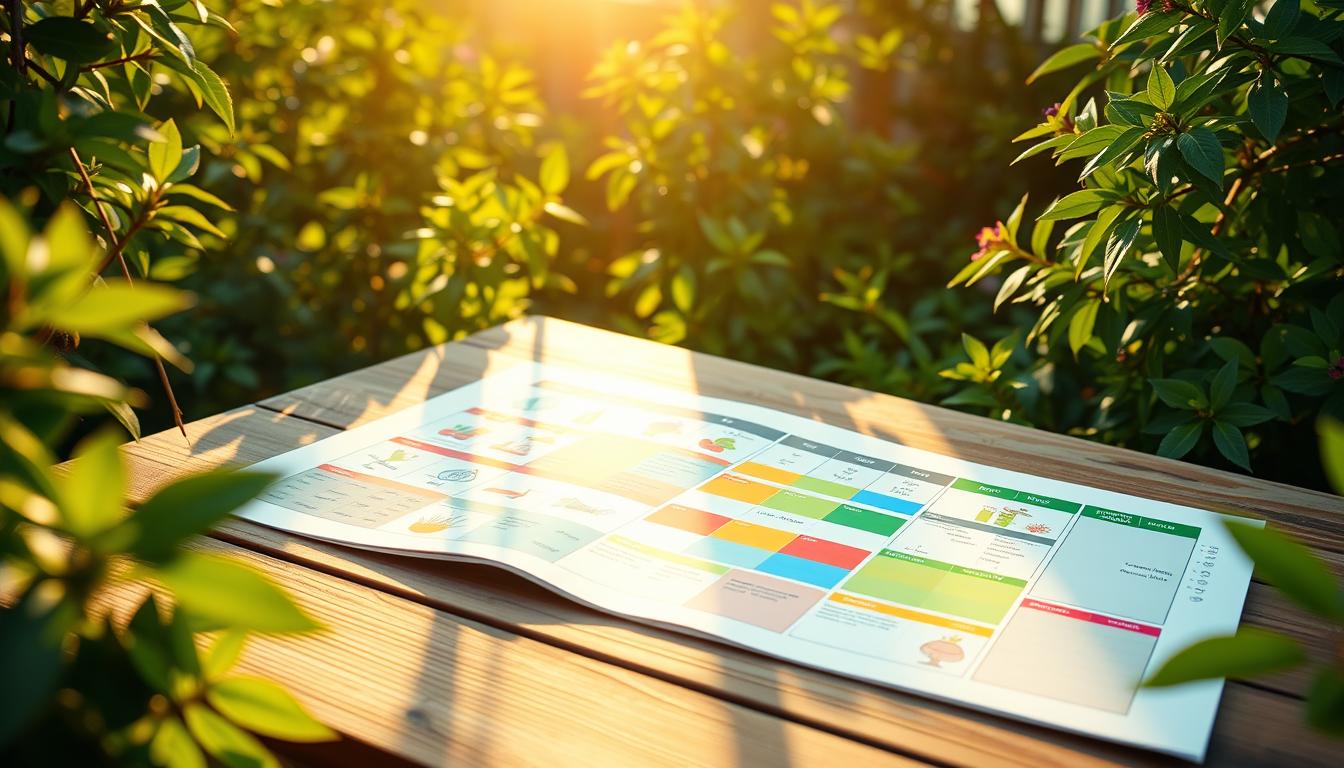Creating a thriving outdoor space requires more than just seeds and soil. It’s about planning, creativity, and patience. A well-organized approach can turn your outdoor area into a source of joy and nourishment throughout the year.
Our 38-page printable tool is designed to help you manage every aspect of your outdoor projects. With a reusable binder format, it’s perfect for multi-year use, allowing you to adapt and refine your plans as your space evolves.
Gardening is a blend of art and science. It’s a process that rewards delayed gratification, much like the work of an artist. As the seasons shift from winter to spring, now is the ideal time to start planning. This tool helps you track planting and harvesting, manage garden beds, and stay organized season after season.
Key Takeaways
- Comprehensive 38-page tool for organizing outdoor spaces.
- Reusable binder format for multi-year planning.
- Perfect for tracking planting, harvesting, and garden beds.
- Ideal for seasonal transitions, especially winter to spring.
- Combines creativity with practical planning for long-term success.
Why You Need a Free Garden Planner Printable
Planning your outdoor space can feel overwhelming, but it doesn’t have to be. A garden planner helps you stay organized and focused, especially during the winter months when preparation is key. Templates from the Axe & Root Homestead collaboration make it easy to plan garden layouts and track progress.
For beginners, starting small is the best way to avoid overwhelm. Focus on one bed at a time, and let the planner guide you. This approach ensures you build confidence while learning the basics of managing your outdoor area.
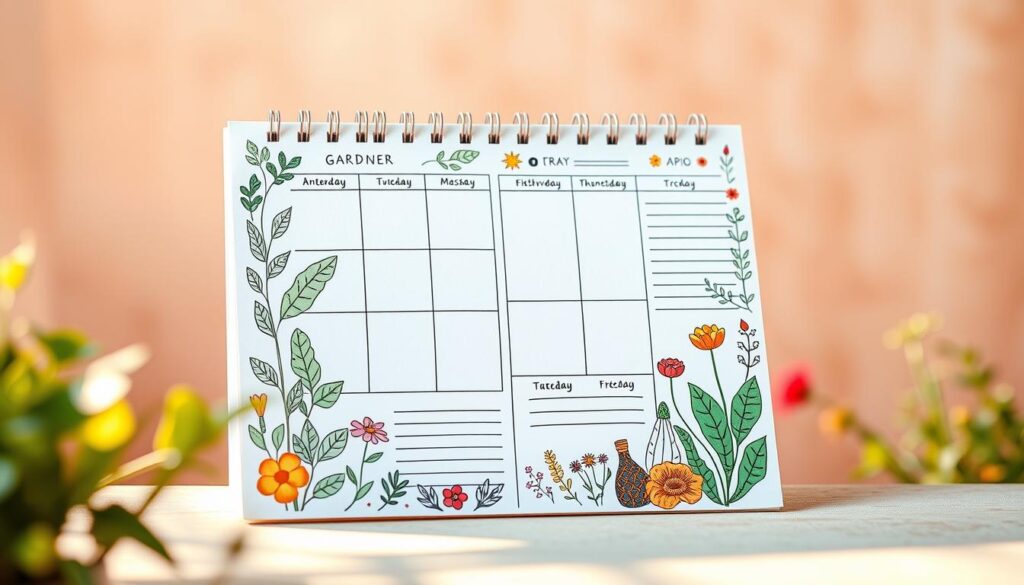
Tracking seed viability and soil amendments is another critical aspect. Keeping records of fertilizers and soil conditions helps you make informed decisions for healthier plants. This method ensures your outdoor space thrives throughout the season.
Family-friendly features, like watercolor garden drawings, make it fun for kids to get involved. These artistic templates encourage creativity while teaching them about nature and responsibility.
Cost-saving benefits are another advantage. Harvest trackers and expense worksheets help you monitor spending and maximize your resources. Here’s a quick breakdown of how a planner can save you money:
| Feature | Benefit |
|---|---|
| Harvest Tracker | Reduces food waste by planning usage. |
| Expense Worksheet | Helps manage budget for seeds and tools. |
| Soil Records | Improves plant health, reducing replacement costs. |
Using a planner is a smart way to save time and money while creating a beautiful outdoor space. Share your progress on a blog or with friends to inspire others to start their own projects.
How to Use Your Free Garden Planner Printable
Getting started with your outdoor project is easier than you think. With a structured approach, you can transform your space into a thriving area. Here’s how to make the most of your planner.
Step 1: Download and Print Your Planner
Begin by downloading the planner from the provided link. Print the pages on high-quality paper or cardstock for durability. If you’re involving kids, consider laminating their templates for reuse.
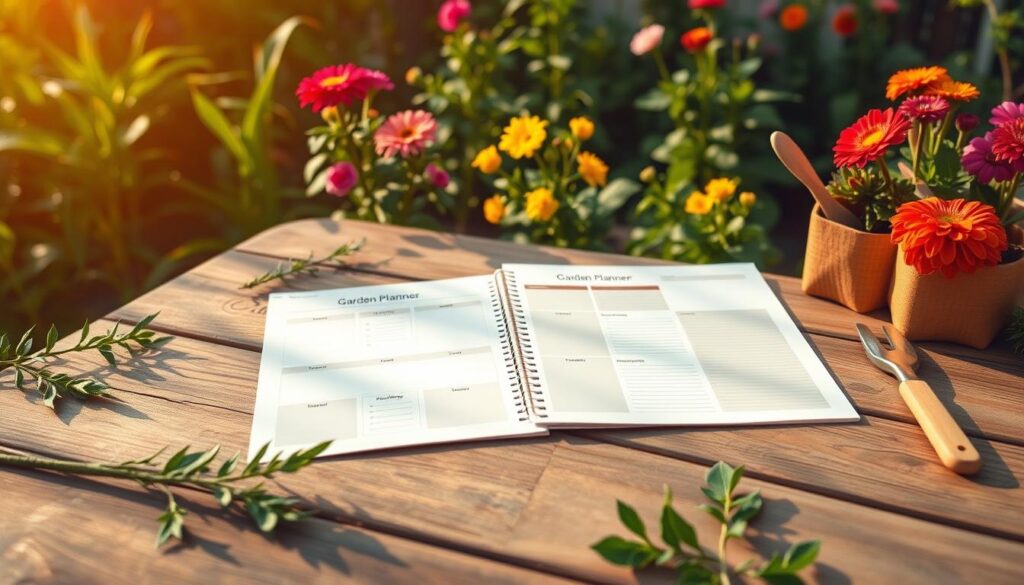
Step 2: Organize Your Garden Beds
Use the gridded bed planner to map out your garden beds. For example, if you’re planting Brandywine tomatoes, allocate space based on their growth requirements. This step ensures efficient use of your outdoor area.
Step 3: Track Your Planting and Harvesting
Document your seed starting process using the seed tracker. Note germination rates and planting dates to monitor progress. The monthly chore lists and project trackers help you stay on top of tasks.
Here’s a quick guide to using the planner effectively:
| Feature | How to Use |
|---|---|
| Gridded Bed Planner | Map out garden beds for optimal space usage. |
| Seed Tracker | Record seed details and germination rates. |
| Monthly Chore Lists | Stay organized with seasonal tasks. |
With these steps, you’ll have a clear plan to manage your outdoor space. Whether you’re a beginner or an experienced gardener, this tool simplifies the process.
Tips for Organizing Your Garden Beds
Organizing your outdoor area efficiently can lead to a more productive and enjoyable experience. Whether you’re a beginner or an experienced gardener, a well-planned approach ensures your space thrives. Here’s how to get started.
Start Small and Expand Over Time
Begin with a single bed to avoid feeling overwhelmed. This approach allows you to focus on learning the basics and building confidence. As you gain experience, you can gradually add more garden beds to your layout.
Baker Creek Heirloom Seeds is a reliable source for high-quality seeds. Their diverse varieties make it easy to find the perfect plants for your space. Starting small also helps you experiment with different varieties without overcommitting.
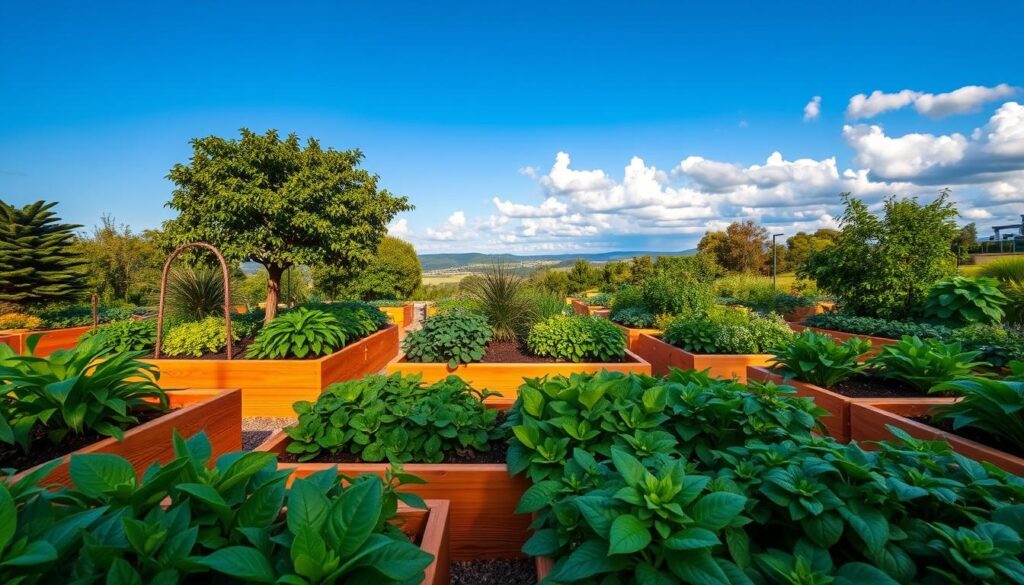
Consider Your Hardiness Zone and Soil Quality
Understanding your hardiness zone is crucial for selecting the right plants. This ensures they thrive throughout the year. Use seasonal planting planners to align your starting dates with your zone’s conditions.
Soil quality plays a significant role in plant health. Consider using an organic soil recipe to enrich your bed. For pest control, refer to trusted guides to keep your garden beds healthy and productive.
Here’s a quick reference for organizing your space:
| Feature | Benefit |
|---|---|
| 8×4 Bed Template | Optimizes space with companion planting. |
| Organic Soil Recipe | Improves soil quality for healthier plants. |
| Pest Control Guides | Protects plants from common threats. |
Paint Water Farm’s evolving design is a great example of thoughtful organization. Their success story highlights the importance of starting small and adapting over time. Share your progress in a blog post to inspire others on their journey.
Seasonal Garden Planning: What to Plant and When
Seasonal changes bring new opportunities to transform your outdoor space. By aligning your efforts with the natural rhythm of the year, you can maximize productivity and enjoyment. Whether you’re planting in spring or preparing for winter, a well-timed approach ensures success.
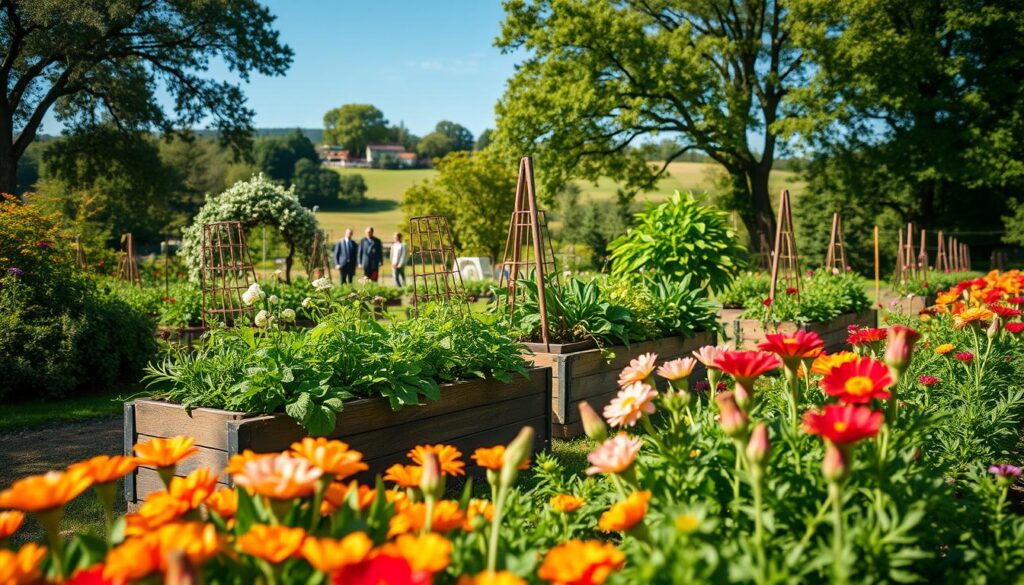
Spring Planting Guide
Spring is the perfect time to kick off your outdoor projects. Start by referencing a monthly planting planner to schedule succession crops. For example, tomatoes and peppers should be started indoors 6-8 weeks before the last frost date. This ensures they’re ready for transplanting when the weather warms up.
Consider using a guide to determine the best varieties for your region. Early spring is also ideal for sowing cool-season crops like lettuce and spinach. These thrive in cooler temperatures and can be harvested before the heat of summer arrives.
Summer Maintenance Tips
Summer is all about nurturing your plants and ensuring they thrive. Regular watering, mulching, and pruning are essential tasks. Use a seasonal chore list to stay on top of these activities. This helps prevent pests and diseases while promoting healthy growth.
Monitor your harvest closely during this time. Remove any overripe produce to encourage continuous production. For example, picking zucchini regularly prevents them from becoming too large and reduces strain on the plant.
Fall and Winter Preparation
As the year winds down, focus on preparing your outdoor space for the colder months. Fall is the ideal time to amend your soil using an amendment tracker. Adding compost or organic matter improves soil structure and fertility for the next growing season.
Winter planning often involves browsing seed catalogs and dreaming of the next year’s projects. Use this time to organize your notes and reflect on what worked well. For more tips on getting started, check out this beginner’s guide.
“The key to a thriving outdoor space is adapting your plans to the seasons. Each month brings new opportunities and challenges.”
By following these seasonal guides, you can create a productive and enjoyable outdoor space throughout the year. Whether you’re planting in spring, maintaining in summer, or preparing for winter, a well-timed approach ensures success.
Creative Ways to Enhance Your Garden Planner
Personalizing your planning process can make it more enjoyable and effective. Adding creative touches not only boosts motivation but also helps you stay organized. Here are some ways to make your tools uniquely yours.
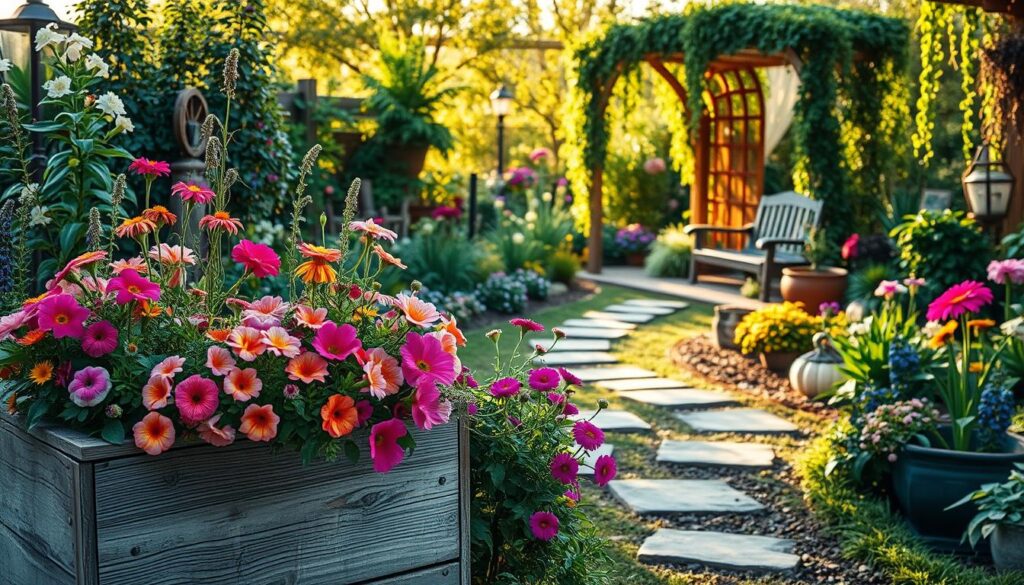
Add Stickers and Washi Tape for Personalization
Decorating your planner with stickers and washi tape is a fun way to make it visually appealing. For example, Azure Farm showcases beautifully decorated planners with artistic touches. These small additions can turn a simple tool into a work of art.
Using index dividers with an alphabetized plant profile system is another great idea. This method keeps your notes organized and easy to access. It’s perfect for gardeners who want to track multiple plants efficiently.
Include a Garden Journal for Reflections
A garden journal is a valuable addition to your planning system. It allows you to reflect on your progress and document important details. Paint Water Farm’s binder setup is an excellent example of how to combine functionality with creativity.
Consider using watercolor templates for artistic planning. These templates add a personal touch while helping you visualize your space. Combining a harvest tracker with recipe development notes is another practical idea. It ensures you make the most of your produce.
“A well-organized journal is the key to a thriving outdoor space. It helps you learn from each season and improve over time.”
By incorporating these creative things, you can transform your planning process into a fun and productive activity. Share your decorated planner on a blog or with fellow gardeners to inspire others. With these links to creativity, your outdoor projects will flourish like never before.
Conclusion
Transform your outdoor projects into a well-organized success with a reusable binder system. This 38-page tool is designed to last for years, helping you adapt and refine your plans as your space evolves. It’s the perfect companion for seasonal transitions, especially as spring approaches.
Share your progress on social media using @azurefarm tags to inspire others. Don’t forget, you can opt out of our email newsletter anytime if it’s not for you. Now is the ideal time to download and start planning before the spring rush begins.
For more tips and inspiration, explore our full gardening post archive. Whether you’re a beginner or an expert, this tool simplifies the process and helps you create a thriving outdoor place for life.

